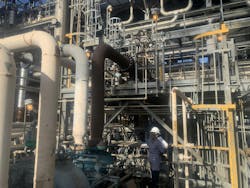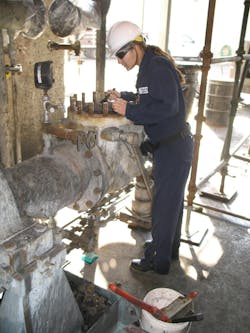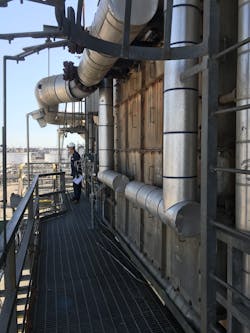America's Safest Companies 2025: Mangan Inc.
Editor's Note: The 2025 class of America's Safety Companies will be recognized Tuesday, October 21, during the Safety Leadership Conference 2025 in Glendale, Ariz. More information about the conference, including registration, can be found at www.safetyleadershipconference.com.
Mangan Inc.
Oil & gas, pipeline, manufacturing, biopharma
Long Beach, CA
375 employees | 9 domestic sites | 2 EHS professionals
Mangan Inc. wants employee feedback—and they mean it.
The company created a program that encourages employees to share reflections and observations of their work environments as well as suggestions for improvement; the program’s name itself, SMART Card, was chosen by employees.
Mary Gurasich, senior safety program manager at Mangan, says the SMART Card program engages employees at a personal level and encourages them to think critically about their environment, document potential hazards and take ownership of their safety decisions.
The safety team reviews every submission—last year, there were over 6,000—and personally follows up as needed. Of those, Gurasich says there were nearly 600 entries that have led to enhanced safety practices and a stronger safety culture.
Some of last year’s SMART Card entries include:
“Very cramped quarters to do work. Be careful of pinch points. Difficult to work comfortably.”
“Be careful logging into [the] system, as there will be multiple individuals accessing the WFAT environment. Make sure that you are not logging into production at all."
“Stay clear of hot steam pipes in water room.”
“It is probably a good idea to have a grab and go bag with the strange weather patterns that Texas has been having.”
“Some areas such as AGI (Acid Gas Injection - Compressor Area) are restricted access due to the eventual presence of H2S (Compass Compressor and Alegacy Compressor). I avoid accessing these areas because they require specific training, use of respirators and monitoring personnel. In other cases, I have had to review VFD configuration with equipment in service, which implies using special suits for prevention in case of ARC Flash.”
“More than a safety tool, SMART Cards create space for honest dialogue and shared responsibility, building a workplace where employees feel safe, heard and truly part of the team,” Gurasich says. “This open and ongoing feedback loop reinforces that every voice matters, especially in remote or solitary work settings where employees may otherwise feel isolated.”
Mangan employees work in highly hazardous and secure field environments, including chemical processes and electrical. It’s not always possible to have a member of the safety team on-site, so employees must be responsible for their own safety.
Employees are trained to audit and inspect their environment routinely. If they don’t think it is safe to proceed, they have full stop-work authority. Gurasich says that’s helped to drive employee engagement and create lasting cultural change.
Gurasich also says she’s seen a meaningful shift in employees’ behavior and engagement over time. Employees who were once disengaged are now vocal advocates for safety. New hires quickly align with Mangan’s safety culture, too.
“It’s embedded in how we operate, not just through training, but through daily actions and expectations modeled by peers and leadership,” she says.
About 25% of Mangan’s workforce volunteers to support safety in addition to their primary responsibilities. Some examples of how non-safety personnel support safety include:
- corporate safety program stewards at local offices;
- safety committee participation;
- electrical safety committee participation;
- employees who are trained as first responders;
- employees who are trained to administer CPR, AED and first aid;
- employees who train and ensure compliance on electrical safety; and
- designated red hats at offices with more than 10 employees who coordinate evacuations and shelter-in-place during emergency situations.
Mangan, which was previously named one of America’s Safest Companies of 2017, has developed an extensive assortment of leading and lagging indicators to assess the effectiveness of its safety program and identify areas for improvement. Some leading indicators include safety training completion rates, recorded participation in safety meetings, job hazard analysis reviews, and inspections and audit findings.
Because many employees perform electrical work in lone or confined spaces, direct observation by the safety team is not feasible. This poses a challenge for OSHA’s requirement for verifying an employee’s knowledge and experience to determine Qualified Person status. In response, Mangan has developed an electrical safety program to meet its specific needs—above and beyond those set forth by OSHA and NFPA 70E standards.
Mangan’s electrical vetting process of interested employees begins with an electrical assessment and survey. Those results are used to populate an electrical interview form that is then reviewed by a vetted, qualified member of their electrical safety resource team. During the interview, potential employee eligibility is evaluated for specific voltage levels and activity types, categorized as surveying, operating or meter use.
If the employee demonstrates sufficient knowledge and experience, they are enrolled in targeted training assignments to fulfill OSHA’s requirements for Qualified Person status. If not, the employee is enrolled into an electrical mentoring program to receive additional training so they can develop the necessary competencies.
Collectively, these efforts have delivered an impressive return on investment: the company has had zero recordable injuries over the past three years.
“Our safety program is not an add-on, a checkbox or a compliance requirement,” Gurasich says. “It’s fully integrated into everything we do. From the start of a project to its close out, safety is embedded in our planning, our operations and our daily interactions.”
About the Author
Nicole Stempak
Nicole Stempak is managing editor of EHS Today and conference content manager of the Safety Leadership Conference.






